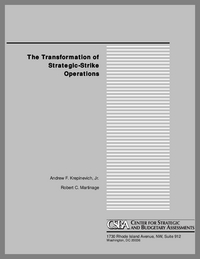
The US military is currently investing billions of dollars annually in developing and deploying a broad range of new precision-guided and electronic-strike weapons. These weapons are revolutionizing the way military organizations are thinking about future conflict. Perhaps nowhere are the potential implications of these weapons more significant than in the case of nuclear forces and strategic-strike operations. For the last forty years, the US strategic deterrent has centered on a triad of intercontinental bombers and land- and sea-based ballistic missile forces.
A strong case can be made that the United States should take steps to create a new strategic-strike triad, relying on its precision- and electronic-strike capabilities to form two of the three legs, with a smaller residual nuclear force comprising the third leg.
Given the current geopolitical landscape and the US lead in developing and deploying nonnuclear precision- and electronic-strategic-strike weapons, it would appear that the residual nuclear force of the new strategic triad might comprise somewhere between 2,000–3,000 warheads. Indeed, given the considerable opportunity costs of maintaining nuclear forces above this level, the United States should strongly consider reducing its current nuclear forces to these levels for strategic reasons, irrespective of current arms control negotiations.
Periods characterized by dramatic surges in technologies, such as those underwriting the development of precision- and electronic-strike weapons, have often led in the past to equally dramatic changes in the conduct of war. These weapons seem likely to blur what was once a relatively clear distinction between nuclear and conventional weapons. The US military may soon be capable of conducting, against certain types of strategic targets, nonnuclear strategic-strike operations at levels of military effectiveness approaching those of nuclear strikes.
As the congressionally appointed National Defense Panel noted in 1997, “Advancing military technologies that merge the capabilities of information systems with precision-guided weaponry and real-time targeting and other new weapons systems may provide a supplement or alternative to the nuclear arsenals of the Cold War.” Thus, although nuclear weapons have dominated discussions of strategic-strike operations since their appearance at the end of World War II, the United States may increasingly be able to rely on both precision-guided munitions (PGMs) and electronic means of attack to effect a significant displacement of nuclear weapons in these operations.
This condition will emerge, in part because, as the world continues its transition away from industrial-based economies and toward information-based ones, there will likely be a corresponding shift in the principal sources of military, economic and political power of states.
The character of the strategic target base will necessarily change to reflect these developments.
The strategic bombardment depicted in old World War II newsreels showed massive bomber raids on steel plants and fire storms ignited by incendiary bombs. Cold War era films projected horrific images of the aftermath of atomic explosions.
Future strategic strikes may instead find militaries, in a growing number of instances, being able to employ well-placed conventional precision and electronic strikes discretely directed against critical elements, or nodes, of an adversary’s center of gravity.



























